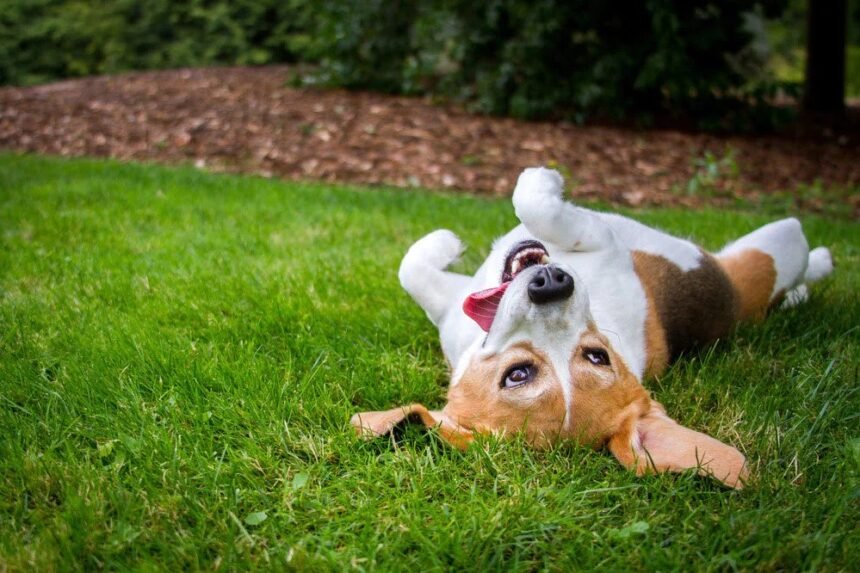Training your dog to roll over is more than just a delightful trick—it’s a valuable exercise in obedience and bonding. This command not only showcases your dog’s intelligence and responsiveness but also enhances your communication with your furry friend.
Why Roll Over is a Fun and Useful Trick
Rolling over is not only entertaining but also practical. It can be a handy command in various situations:
- Physical Exercise: Rolling over engages your dog’s muscles and offers a form of physical activity, helping to keep them in good shape.
- Mental Stimulation: Learning new tricks like rolling over challenges your dog’s cognitive abilities, preventing boredom and destructive behavior.
- Bonding Opportunity: The training process creates a stronger bond between you and your pet. It fosters trust, communication, and a sense of accomplishment for both you and your dog.
- Impressing Friends and Family: Teaching your dog to roll over is a great way to showcase their abilities to friends and family, earning admiration and praise.
- Emergency Situations: In emergency situations, such as when your dog needs to be examined by a veterinarian or groomed, the roll over command can be incredibly useful for ensuring their safety and the safety of those handling them.
Step-by-Step Roll Over Training
Now that you understand the significance of teaching your dog to roll over, let’s delve into the step-by-step process of training this delightful trick. Patience and consistency are key to successful training, so take your time and enjoy the journey with your furry companion.
1. Teaching Your Dog to Lie Down
Before your dog can roll over, they need to master the “lie down” command. If your dog already knows this command, feel free to skip to the next step. Here’s how to teach them to lie down:
- Find a Quiet Training Space: Choose a quiet, distraction-free area for training. A room with minimal noise and minimal foot traffic is ideal.
- Have Treats Ready: Ensure you have some small, tasty treats your dog loves. These will serve as rewards during training.
- Use a Leash and Collar (Optional): If your dog is easily distracted, consider using a leash and collar to help maintain focus.
- Begin the Training Session:
- Start with your dog in a standing position.
- Hold a treat in your hand, close to their nose.
- Slowly move your hand down to the ground, leading your dog’s nose with the treat.
- As your dog follows the treat and lies down, say the command “down.”
- The moment they are in a down position, reward them with the treat and praise.
- Repeat and Reinforce: Practice this several times in each training session until your dog reliably responds to the “down” command.
2. The First Stage: Luring the Roll Over
Once your dog is comfortable with the “lie down” command, it’s time to move on to the first stage of teaching the roll over:
- Get Your Dog in the “Down” Position:
- Ask your dog to “lie down” using the command you’ve trained.
- Ensure they are calm and focused before proceeding.
- Hold a Treat Near Their Nose: With a treat in your hand, hold it near your dog’s nose and let them sniff it.
- Guide Them in a Circle: Slowly move the treat in a circular motion, from their nose to their shoulder, and then along their back.
- Encourage Rolling Over: As your dog follows the treat’s path with their nose, they should naturally start to roll over onto their side and eventually onto their back.
- Reward and Praise: The moment your dog completes the roll over, reward them with the treat and offer plenty of praise.
3. The Second Stage: Shaping the Roll Over
The second stage involves refining the roll over command and teaching your dog to do it without the continuous lure of a treat:
- Start with the “Down” Command: Begin by asking your dog to “lie down.”
- Offer an Empty Hand Signal: Instead of holding a treat, use an empty hand to guide your dog in a circle as before.
- Add a Verbal Cue: Simultaneously, introduce a verbal cue such as “roll over” as you guide them.
- Reward and Repeat: When your dog successfully rolls over upon hearing the cue, reward them with a treat and praise. Repeat this step to reinforce the behavior.
4. Troubleshooting Common Challenges
Throughout the training process, you may encounter some challenges. Here are solutions to common issues:
- Lack of Interest: If your dog seems disinterested or distracted, try training in shorter, more engaging sessions. Use high-value treats to maintain their focus.
- Overexcitement: Some dogs may become overly excited during training. In such cases, take short breaks to calm them down, then resume.
- Difficulty Rolling Over: If your dog struggles to complete the roll over, break the movement into smaller steps and reward each partial attempt until they grasp the full command.\
- Frustration: Both you and your dog may experience frustration at times. Stay patient, and if needed, seek guidance from a professional dog trainer.
Remember, every dog learns at their own pace. With consistent practice and positive reinforcement, your furry friend will master the roll over command in no time.
Advanced Tips and Variations
Once your dog has mastered the basic roll over command, you can take their training to the next level with advanced tips and exciting variations. These additions will not only impress onlookers but also continue to stimulate your dog’s mind and strengthen your bond.
1. Adding Verbal Cues and Hand Signals
To refine your dog’s roll over skills, consider incorporating verbal cues and hand signals:
- Verbal Cue: Choose a specific word or phrase like “roll over” or “spin.” Be consistent with your chosen cue, using it every time you want your dog to perform the trick.
- Hand Signal: In addition to the verbal cue, introduce a hand signal that accompanies the command. For example, a clockwise circular motion with your hand can signal “roll over.” This combination of verbal and visual cues enhances your dog’s understanding and responsiveness.
- Practice: In training sessions, use both the verbal cue and hand signal together. Gradually, you can transition to using only the cue or signal, testing your dog’s ability to respond to each.
2. Training for Multiple Repetitions
Once your dog can perform a single roll over flawlessly, challenge them by asking for multiple repetitions in a row:
- Repeat the Command: After your dog has rolled over once, immediately issue the command again.
- Continuous Reinforcement: Keep rewarding your dog after each successful roll over. This encourages them to perform the trick multiple times in succession.
- Gradual Increase: Start with two or three repetitions and gradually increase the number as your dog becomes more proficient. This not only showcases their skills but also provides excellent mental exercise.
3. Combining Tricks
Another advanced option is to combine roll over with other tricks your dog knows, creating impressive sequences. For example, after your dog rolls over, you can have them “sit” or “stay” before proceeding with the next trick. This showcases your dog’s versatility and your training expertise.
4. Incorporating Props
For added flair, introduce props into the roll over routine. You can have your dog roll over a small hoop or between your legs. Gradually introduce these props, rewarding your dog for successfully navigating them during the roll over.
5. Chaining Tricks
Take your dog’s training to a higher level by chaining multiple tricks together. For instance, you can have your dog “sit,” then “lie down,” followed by a “roll over,” and finally a “high-five.” Chaining tricks not only demonstrates your dog’s intelligence but also strengthens their ability to follow a sequence of commands.
6. Seek Professional Guidance
If you’re aiming for advanced levels of training or facing specific challenges, consider consulting a professional dog trainer. They can provide personalized guidance, identify areas for improvement, and help you and your dog achieve remarkable results.
Remember, advanced training should always be enjoyable for both you and your dog. Keep training sessions positive, and be sure to celebrate your dog’s achievements, no matter how small or large. Teaching your dog to roll over is a fulfilling journey that strengthens your bond. Embrace the process and enjoy every moment of progress. Happy training!







